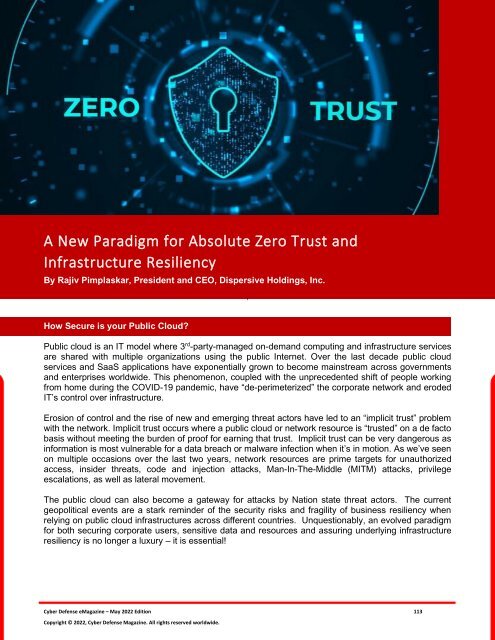Cyber Defense eMagazine May Edition for 2022
Cyber Defense eMagazine May Edition for 2022 #CDM #CYBERDEFENSEMAG @CyberDefenseMag by @Miliefsky a world-renowned cyber security expert and the Publisher of Cyber Defense Magazine as part of the Cyber Defense Media Group as well as Yan Ross, Editor-in-Chief and many more writers, partners and supporters who make this an awesome publication! Thank you all and to our readers! OSINT ROCKS! #CDM #CDMG #OSINT #CYBERSECURITY #INFOSEC #BEST #PRACTICES #TIPS #TECHNIQUES
Cyber Defense eMagazine May Edition for 2022 #CDM #CYBERDEFENSEMAG @CyberDefenseMag by @Miliefsky a world-renowned cyber security expert and the Publisher of Cyber Defense Magazine as part of the Cyber Defense Media Group as well as Yan Ross, Editor-in-Chief and many more writers, partners and supporters who make this an awesome publication! Thank you all and to our readers! OSINT ROCKS! #CDM #CDMG #OSINT #CYBERSECURITY #INFOSEC #BEST #PRACTICES #TIPS #TECHNIQUES
- No tags were found...
Create successful ePaper yourself
Turn your PDF publications into a flip-book with our unique Google optimized e-Paper software.
A New Paradigm <strong>for</strong> Absolute Zero Trust and<br />
Infrastructure Resiliency<br />
By Rajiv Pimplaskar, President and CEO, Dispersive Holdings, Inc.<br />
,<br />
How Secure is your Public Cloud?<br />
Public cloud is an IT model where 3 rd -party-managed on-demand computing and infrastructure services<br />
are shared with multiple organizations using the public Internet. Over the last decade public cloud<br />
services and SaaS applications have exponentially grown to become mainstream across governments<br />
and enterprises worldwide. This phenomenon, coupled with the unprecedented shift of people working<br />
from home during the COVID-19 pandemic, have “de-perimeterized” the corporate network and eroded<br />
IT’s control over infrastructure.<br />
Erosion of control and the rise of new and emerging threat actors have led to an “implicit trust” problem<br />
with the network. Implicit trust occurs where a public cloud or network resource is “trusted” on a de facto<br />
basis without meeting the burden of proof <strong>for</strong> earning that trust. Implicit trust can be very dangerous as<br />
in<strong>for</strong>mation is most vulnerable <strong>for</strong> a data breach or malware infection when it’s in motion. As we’ve seen<br />
on multiple occasions over the last two years, network resources are prime targets <strong>for</strong> unauthorized<br />
access, insider threats, code and injection attacks, Man-In-The-Middle (MITM) attacks, privilege<br />
escalations, as well as lateral movement.<br />
The public cloud can also become a gateway <strong>for</strong> attacks by Nation state threat actors. The current<br />
geopolitical events are a stark reminder of the security risks and fragility of business resiliency when<br />
relying on public cloud infrastructures across different countries. Unquestionably, an evolved paradigm<br />
<strong>for</strong> both securing corporate users, sensitive data and resources and assuring underlying infrastructure<br />
resiliency is no longer a luxury – it is essential!<br />
<strong>Cyber</strong> <strong>Defense</strong> <strong>eMagazine</strong> – <strong>May</strong> <strong>2022</strong> <strong>Edition</strong> 113<br />
Copyright © <strong>2022</strong>, <strong>Cyber</strong> <strong>Defense</strong> Magazine. All rights reserved worldwide.


















